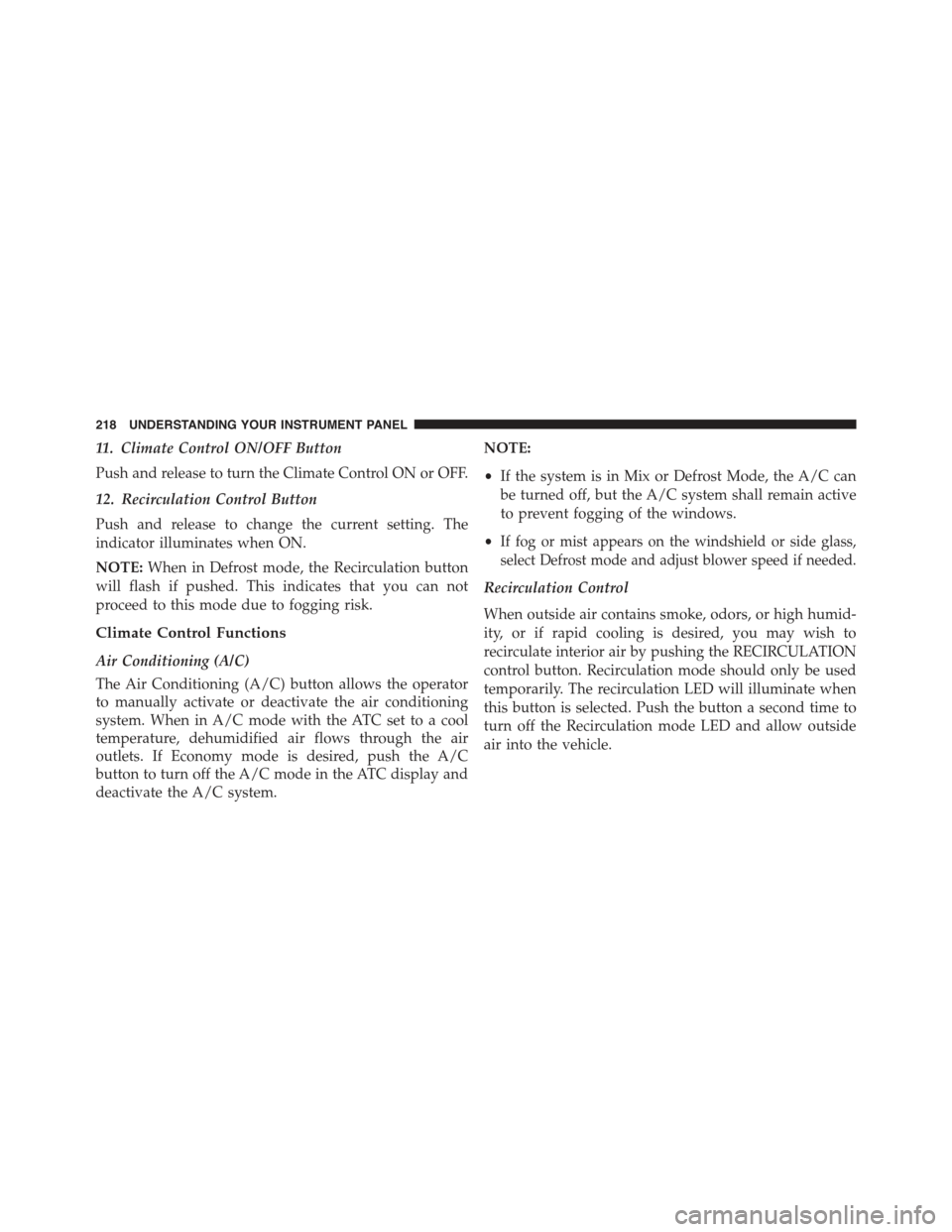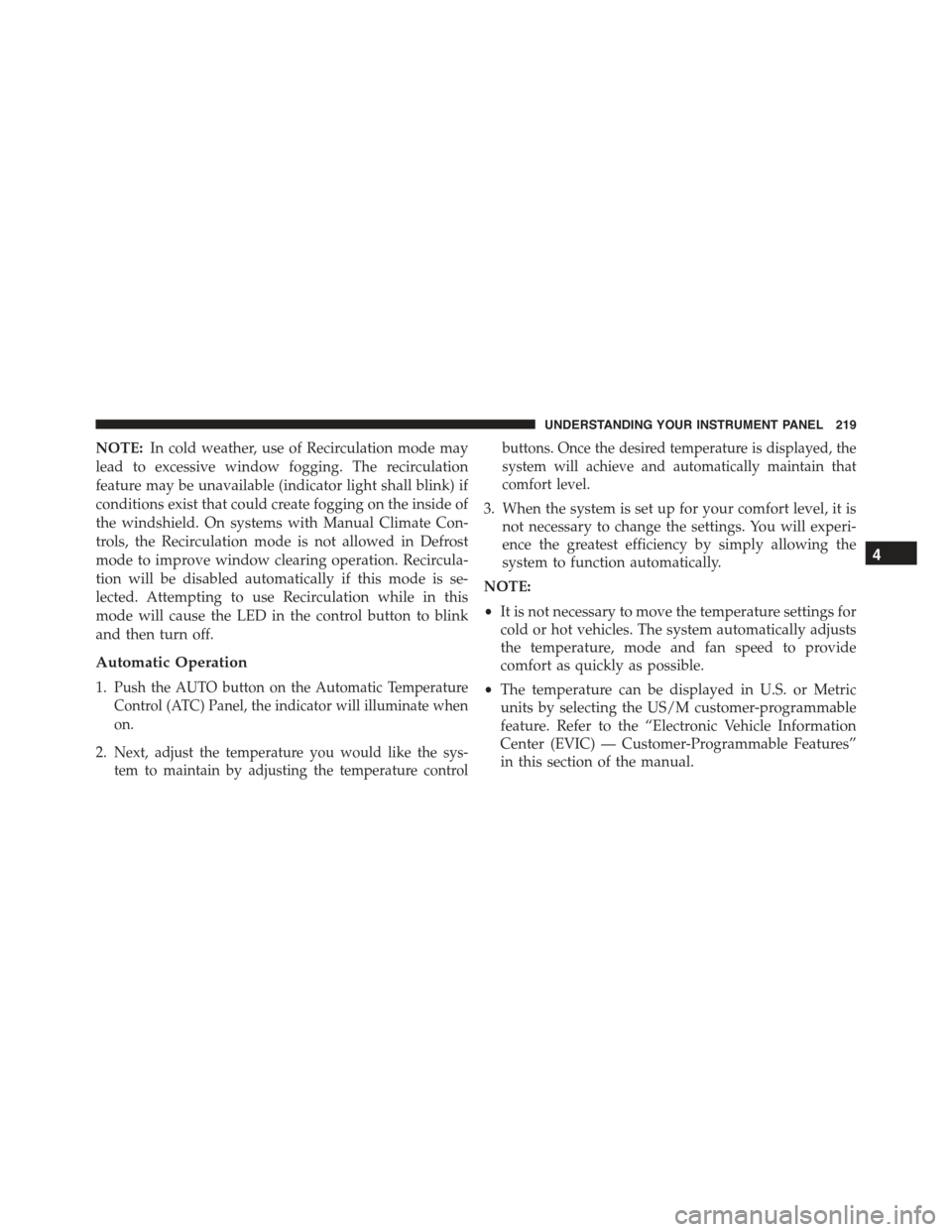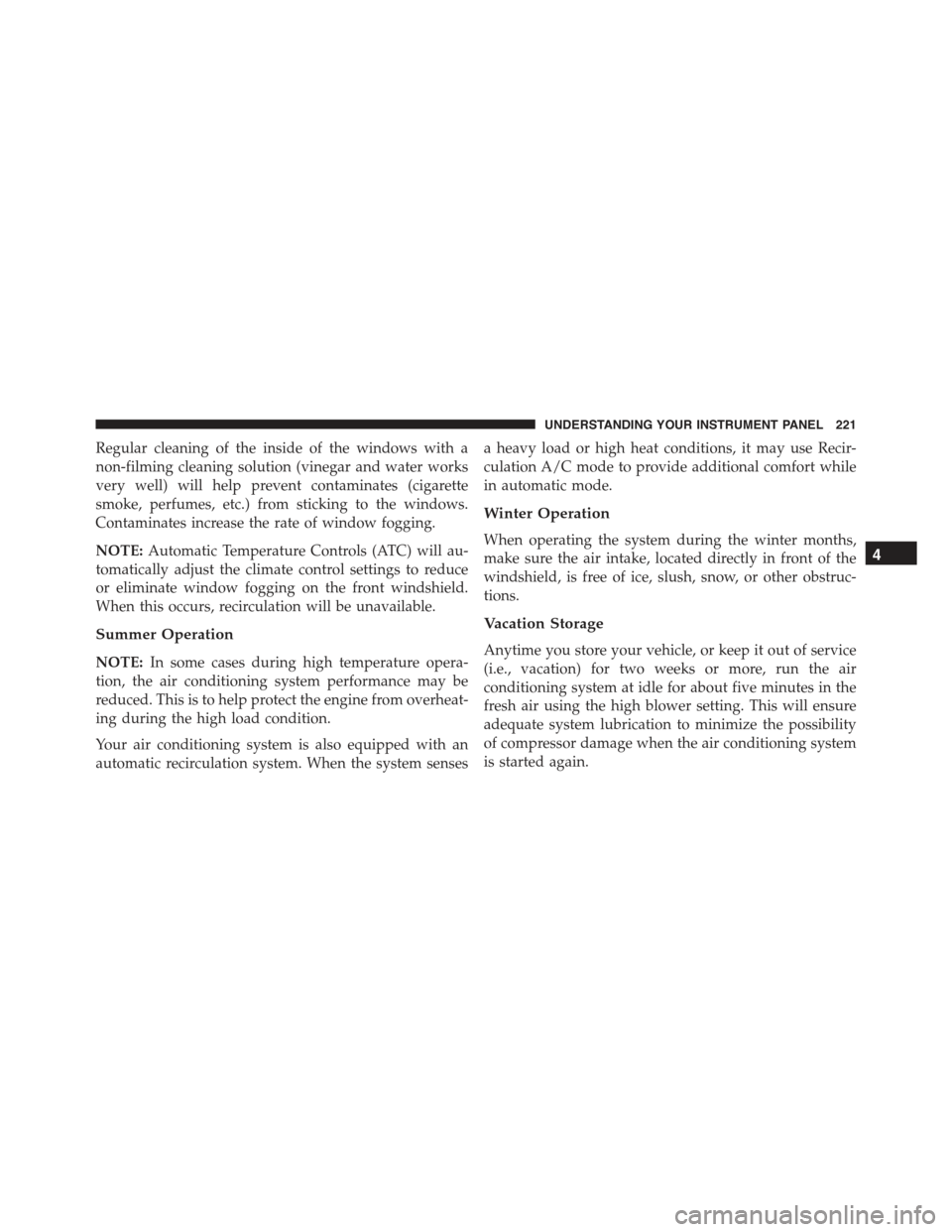Page 220 of 426

11. Climate Control ON/OFF Button
Push and release to turn the Climate Control ON or OFF.
12. Recirculation Control Button
Push and release to change the current setting. The
indicator illuminates when ON.
NOTE:When in Defrost mode, the Recirculation button
will flash if pushed. This indicates that you can not
proceed to this mode due to fogging risk.
Climate Control Functions
Air Conditioning (A/C)
The Air Conditioning (A/C) button allows the operator
to manually activate or deactivate the air conditioning
system. When in A/C mode with the ATC set to a cool
temperature, dehumidified air flows through the air
outlets. If Economy mode is desired, push the A/C
button to turn off the A/C mode in the ATC display and
deactivate the A/C system.
NOTE:
•If the system is in Mix or Defrost Mode, the A/C can
be turned off, but the A/C system shall remain active
to prevent fogging of the windows.
•If fog or mist appears on the windshield or side glass,
select Defrost mode and adjust blower speed if needed.
Recirculation Control
When outside air contains smoke, odors, or high humid-
ity, or if rapid cooling is desired, you may wish to
recirculate interior air by pushing the RECIRCULATION
control button. Recirculation mode should only be used
temporarily. The recirculation LED will illuminate when
this button is selected. Push the button a second time to
turn off the Recirculation mode LED and allow outside
air into the vehicle.
218 UNDERSTANDING YOUR INSTRUMENT PANEL
Page 221 of 426

NOTE:In cold weather, use of Recirculation mode may
lead to excessive window fogging. The recirculation
feature may be unavailable (indicator light shall blink) if
conditions exist that could create fogging on the inside of
the windshield. On systems with Manual Climate Con-
trols, the Recirculation mode is not allowed in Defrost
mode to improve window clearing operation. Recircula-
tion will be disabled automatically if this mode is se-
lected. Attempting to use Recirculation while in this
mode will cause the LED in the control button to blink
and then turn off.
Automatic Operation
1.Push the AUTO button on the Automatic Temperature
Control (ATC) Panel, the indicator will illuminate when
on.
2.Next, adjust the temperature you would like the sys-
tem to maintain by adjusting the temperature control
buttons. Once the desired temperature is displayed, the
system will achieve and automatically maintain that
comfort level.
3. When the system is set up for your comfort level, it is
not necessary to change the settings. You will experi-
ence the greatest efficiency by simply allowing the
system to function automatically.
NOTE:
•It is not necessary to move the temperature settings for
cold or hot vehicles. The system automatically adjusts
the temperature, mode and fan speed to provide
comfort as quickly as possible.
•The temperature can be displayed in U.S. or Metric
units by selecting the US/M customer-programmable
feature. Refer to the “Electronic Vehicle Information
Center (EVIC) — Customer-Programmable Features”
in this section of the manual.
4
UNDERSTANDING YOUR INSTRUMENT PANEL 219
Page 223 of 426

Regular cleaning of the inside of the windows with a
non-filming cleaning solution (vinegar and water works
very well) will help prevent contaminates (cigarette
smoke, perfumes, etc.) from sticking to the windows.
Contaminates increase the rate of window fogging.
NOTE:Automatic Temperature Controls (ATC) will au-
tomatically adjust the climate control settings to reduce
or eliminate window fogging on the front windshield.
When this occurs, recirculation will be unavailable.
Summer Operation
NOTE:In some cases during high temperature opera-
tion, the air conditioning system performance may be
reduced. This is to help protect the engine from overheat-
ing during the high load condition.
Your air conditioning system is also equipped with an
automatic recirculation system. When the system senses
a heavy load or high heat conditions, it may use Recir-
culation A/C mode to provide additional comfort while
in automatic mode.
Winter Operation
When operating the system during the winter months,
make sure the air intake, located directly in front of the
windshield, is free of ice, slush, snow, or other obstruc-
tions.
Vacation Storage
Anytime you store your vehicle, or keep it out of service
(i.e., vacation) for two weeks or more, run the air
conditioning system at idle for about five minutes in the
fresh air using the high blower setting. This will ensure
adequate system lubrication to minimize the possibility
of compressor damage when the air conditioning system
is started again.
4
UNDERSTANDING YOUR INSTRUMENT PANEL 221
Page 380 of 426
CavityVehicle Fuse
NumberMini FuseDescription
3F535 Amp Tan Instrument Panel Node
4F3820 Amp Yellow Central Door Locking
5F3610 Amp Red Diagnostic Socket, Car Radio, Climate Control System
6F4320 Amp Yellow Bi-Directional Washer
7F4820 Amp Yellow Passenger Power Window
8F137.5 Amp Brown Left Low Beam, Headlamp Leveling
9F507.5 Amp Brown Airbag
10F515 Amp Tan Car Radio Switch, Climate Control System, Stop
Light, Clutch
11F375 Amp Tan Stop Light Switch, Instrument Panel Node
12F495 Amp Tan Exterior Mirror, GPS, Electric Mirror, Parking Sensor
13F315 Amp Tan Ignition, Climate Control
14F4720 Amp Yellow Driver Power Window
378 MAINTAINING YOUR VEHICLE
Page 406 of 426

Treadwear
The Treadwear grade is a comparative rating, based on
the wear rate of the tire when tested under controlled
conditions on a specified government test course. For
example, a tire graded 150 would wear one and one-half
times as well on the government course as a tire graded
100. The relative performance of tires depends upon the
actual conditions of their use, however, and may depart
significantly from the norm due to variations in driving
habits, service practices, and differences in road charac-
teristics and climate.
Traction Grades
The Traction grades, from highest to lowest, are AA, A, B,
and C. These grades represent the tire’s ability to stop on
wet pavement, as measured under controlled conditions
on specified government test surfaces of asphalt and
concrete. A tire marked C may have poor traction perfor-
mance.
WARNING!
The traction grade assigned to this tire is based on
straight-ahead braking traction tests, and does not
include acceleration, cornering, hydroplaning, or
peak traction characteristics.
Temperature Grades
The temperature grades are A (the highest), B, and C,
representing the tire’s resistance to the generation of heat
and its ability to dissipate heat, when tested under
controlled conditions on a specified indoor laboratory
test wheel. Sustained high temperature can cause the
material of the tire to degenerate and reduce tire life, and
excessive temperature can lead to sudden tire failure. The
grade C corresponds to a level of performance, which all
passenger car tires must meet under the Federal Motor
404 IF YOU NEED CONSUMER ASSISTANCE
Page 412 of 426

Cellular Phone...........................211
Chains, Tire.............................284
Changing A Flat Tire.......................320
Chart, Tire Sizing.........................262
Check Engine Light (Malfunction Indicator Light) . .148
Checking Your Vehicle For Safety...............77
Checks, Safety............................77
Child Restraint............................56
Child Restraints
Booster Seats...........................60
Child Restraints.........................56
Child Seat Installation.....................73
How To Stow An Unused ALR Seat Belt........69
Infants And Child Restraints................58
Install A LATCH-compatible Child Restraint.....68
Installing Child Restraints Using The Vehicle Seat
Belt..................................70
Lower Anchors And Tethers For Children.......63
Older Children And Child Restraints..........59
Seating Positions........................62
Clean Air Gasoline........................296
Cleaning
Wheels...............................371
Climate Control..........................211
Clutch.................................364
Clutch Fluid.............................364
Compact Disc (CD) Maintenance..............210
Compact Spare Tire........................279
Connector
UCI . . . . . . . . . . . . . . . . . . . . . . . . . . . . . . . ..208
Universal Consumer Interface (UCI)..........208
Contract, Service..........................400
Coolant (Antifreeze).......................387
Cooling System...........................358
Adding Coolant (Antifreeze)...............360
Coolant Level..........................359
Disposal of Used Coolant.................362
Drain, Flush, and Refill...................359
410 INDEX